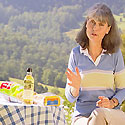Nutritionist, Dr Rosemary Stanton, says that even though many foods are labelled ‘light’ (or ‘lite’), they may still contain substantial quantities of fat and kilojoules.
Confusing labels
Product labels are supposed to tell you why a product is ‘light’, but the message is often unclear. In some foods, the word ‘light’ has no nutritional implication at all, as in ‘light’ fruitcake, which refers to its yellowish crumb colour compared with ‘dark’ fruitcake. Both cakes have similar amounts of fat and sugar. ‘Light’ olive oil and new ‘light’ sunflower oils have less flavour and are light in colour, but, like all oils, they are 100% fat. Ironically, if you’re using oil to add flavour, you’ll probably end up using more of a ‘light’ oil because they’re so tasteless. An extra virgin olive oil with its stronger, more peppery flavour allows more taste from a smaller quantity. ‘Light’ can indicate less fat, but that doesn’t necessarily mean ‘low-fat’. ‘Light’ margarine, for example, has 60% fat – less than the 80% in regular margarine, but it’s still a very fatty food. For comparison, a creamy camembert has 30% fat – about half as much fat as ‘light’ margarine.
Light foods and their fat
Light fat content (g/100g), Regular fat content (g/100g)
Margarine spread 60g, 80g
Butter spread 40g, 80g
Peanut butter 38g, 50g
Cheddar 7-26g, 33g
Cream cheese 21g, 33g
Cream 18g, 35g
Coconut milk 6-17g, 5-36g
Mars bar 12g, 17g
Chocolate cookies 9g, 17g
Apple pie 9g, 14-20g
Potato chips 32g, 32 g
Apart from the chips, all these foods have less fat than the regular product, but they’re not low-fat and you’d be unlikely to achieve a low-fat diet if you ate them all.
Crazy terms
Low-fat should officially only appear on foods with a maximum of 3% fat (or 1.5% fat in a liquid food). These are also the only foods that are officially permitted to carry a label that makes a ‘% fat-free’ claim. This means you should only ever see claims for foods being 97%, 98% or 99% fat-free. There is obviously very little checking because plenty of items in the average supermarket carry labels claiming 92% fat-free, 91% fat-free or some other figure. Some foods meet the low-fat claim per 100g, and so can be labelled as 97% fat-free, but their large serving size means you end up getting much more than 3g of fat.
What to do
If you want to cut down on the fat in your diet, you may need to shop with a calculator and set aside plenty of time to read food labels! A better idea is to follow Rosemary’s recommendation, and go back to eating fresh foods and healthy snacks like fruit.
Rosemary believes we need better, and strongly enforced, rules for food labels. If you agree, you could write to the Australia New Zealand Food Authority and tell them so. Their address is:
PO Box 7186
Canberra BC, ACT 2610
or email: [email protected]



